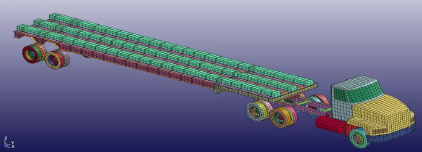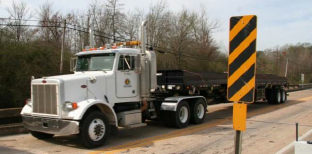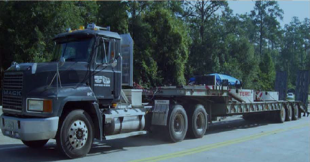Impact and Feasibility Study of Solutions for Doubling Heavy Vehicles
Project Description:
The objective of this research is to quantify the effect of meeting increasing freight demands with heavier trucks to reduce the growth in the number of trucks on the road; and to compare the effect of heavier trucks to the effect of doubling the number of heavy vehicles under the present legal weight restrictions. Ongoing research tasks includes the following:
- Development of computer models of vehicle, bridge, and surface roughness
- Dynamic Analysis of bridge due to moving vehicles;
- Fatigue Life Assessment; and estimating the bridge network costs associated with changes in the limits on legal and permit gross weight, axle weights, or axle configurations;
- Quantification of better or worse bridge durability and longevity when compared to increasing the number of trucks to meet freight demands;
- Truck configurations that minimize the detrimental effect on bridges. Demonstration of the method will be provided with Alabama Bridge Case Study;
- Investigate the Florida I-Beam (FIB) Girders under Heavy Vehicle Load (Review Development of Bridges, Loads, Characteristics, Advantages of New Bridges under given loads); and
- Development of FE Models of 3 Bridges (w/AASHTO & FIB Girders)(Detailed Model Details, Evaluation, Load Rating Analysis)
Final Report
Impact and Feasibility Study of Solutions for Doubling Heavy Vehicles
Presentations:
- "Comparative Performance Analysis of Two Bridges Designed using AASHTO and Florida I-Beam Girders", presented at the 11th International Conference on Structural Safety and Reliability at Columbia University, New York City, New York, June 16-20, 2013.
- "Damage detection of a bridge model based on strain modal analysis", presented at the Fourth International Symposium on Life-Cycle Civil Engineering, IALCCE,in Tokyo, Japan, November 16-19, 2014.
- "Impact and feasibility solution for of doubling heavy vehicles", presented at the CATSS-UTC Symposium in Orlando, Florida, April 2014.
- "Impact of doubling heavy vehicles on bridges", presented at the 2013 UTC Conference for the Southeastern Region in Orlando, Florida, April 5, 2013.
- "Operational Damage Detection of a Bridge Based Using FBG and Vibration Measurements", presented at the 11th International Congress on Advances in Civil Engineering- ACE 2014, Istanbul, Turkey, October 21-25, 2014.
- "Simulation of Bridge Responses to Heavy Vehicles", presented at the 2014 UTC Conference for the Southeastern Region in Atlanta, Georgia, March 24-25, 2014.
Project Information Forms:
Publications:
- Catbas, F.N., Darwash, H. and Fadul, M. (2012) “Modeling & Load Rating of Two Bridges Designed with AASHTO and Florida I-Beam Girders,” Transportation Research Record: Journal of the Transportation Research Board and also presentation at the Transportation Research Board of the National Academies meeting, Washington DC.
- Peng, K. and Catbas, F.N. (2014) " Comparative Analysis of Bridges with AASHTO and Florida I-Beam Girder," Journal of Civil Engineering and Architecture, Feb. 2014, Volume 8, No. 2 (Serial No. 75), pp. 151-159.
Describe Implementation of Research Outcomes (or why not implemented) :
- A method to characterize the representative vehicle including the gross vehicle weight and axle load over a return period of interest.
- A method and tool to characterize the bridge population sensitive to the load effect and fatigue
- The simulation and code can be used for both steel girder and prestressed concrete bridges; and for innovative bridge solutions
- The simulation and code can be used to investigate the effects of different span lengths
- The simulation and code can be used to account for the different classes of road surface roughness
- Investigate effect of dynamic loading including the impact increasing number of heavy vehicles and/or the vehicle weight limit on the service life of bridges.
- 2D and 3D simulation technique, and written MATLAB code can be used to determine the static and dynamic responses of bridges traveling on the bridge and for different combination of truck loads; and different vehicle speeds on the dynamic response of bridges
Significant results from the current quarter includes the following:
- Task 1: Develop heavy vehicle-bridge interaction model to quantify the effect of meeting increasing freight demands on bridges.
- Derivations of equations of the motion for different types of trucks (FIU) – 100%
- Develop Truck Models and Bridge Types (UAB + FIU) – 100%
- Detailed FE Modeling of a Bridge (UAB) – 100%
- Task 2. Compare the effect of heavier trucks to the effect of doubling the number of heavy vehicles under the present legal weight restrictions.
- Design of steel and prestressed concrete bridges with different span lengths (FIU) -100%
- Write MATLAB code to solve the interaction equations for the vehicle models and beam system (FIU) - 100%
- Dynamic Analysis of bridge due to moving vehicles (UAB+FIU) – 90%
- Task 3. Characterize the traffic measured by WIM data in terms of its influence on characteristic bridge load effect
- Characterize WIM data to detect the most reasonable expected extreme gross vehicle weight (UAB) – 100%
- Determine the characteristic Bridge under traffic load effects and Fatigue by WIM Data (UAB+UCF) – 90%
- Task 4. Calculate the characteristic bridge traffic load effects bridges of different lengths.
- Explore existing (conventional AASHTO) and future bridges (Florida I-Beam Girdr) perform (UCF) - 100%
- Explore Florida Legal Load effects on the existing (conventional AASHTO) and future bridges (Florida I-Beam Girder) perform (UCF) - 100%
- Modeling Deck and Girders of AASHTO and FIB Girders (UCF+UAB) - 80%
- Task 5: Calculate the cost effects of increasing loads on bridges
- Load rating of existing (conventional AASHTO) and future bridges (Florida I-Beam Girder) under AASHTO and Florida Legal Loads (UCF) - 90%
- Probabilistic analysis and reliability estimation of existing (conventional AASHTO) and future bridges (Florida I-Beam Girder) under AASHTO and Florida Legal Loads (UCF) - 50%
- Evaluation of existing (conventional AASHTO) and future bridges (Florida I-Beam Girder) under different damage scenarios (UCF) - 50%
- Fatigue life assessment (FIU) - 30%
- Cost impact assessment for all cost-impact categories (UAB) - 50%
Impacts/Benefits of Implementation (actual, not anticipated):
- Finding the Answer To The Rising Demand For Freight Shipping:
- Bridge behavior with increasing the number of trucks traveling on the road
- Bridge behavior with using trucks with higher capacities
- Combination of the two solutions
- Investigate innovative bridge design e.g., FIB as design solution
- Knowing the trends in permits weights in excess of legal limits and resulting damage costs with appropriate design solutions and actions is extremely important:
- Better utilization of bridges
- Possible increase in load demands within safety limits
- Understanding damage locationsfor condition‐based maintenance of bridges
- Making long‐term programmatic decision regarding truck size and weight that in the best interest of our transportation infrastructure.
- Some bridge response measures such as the Dynamic Amplification Factor (DAF) of bridges will be obtained. These measures have important effects on the design of highway bridges and also to understand the durability of current bridges.
Photos 6 through 10 below are provided courtesy of Rahul Kalyankar of UAB, and Dr. Leslaw Kwasniewski of FSU.
Principal Investigator(s):
Principal Investigator(s) Contact Information:
Department of Civil, Construction, and Environmental Engineering The University of Alabama at Birmingham 1075 13th Street South Birmingham, Alabama 35294-4440 Telephone: (205) 934-8432, Fax: (205) 934-9855 Email: nuddin@uab.edu
University(ies):
University of Alabama at Birmingham
Start and End Dates:
5/1/2012 – 08/30/14
Topic:
Safety
State-of-Good-Repair
Theme by Danetsoft and Danang Probo Sayekti inspired by Maksimer


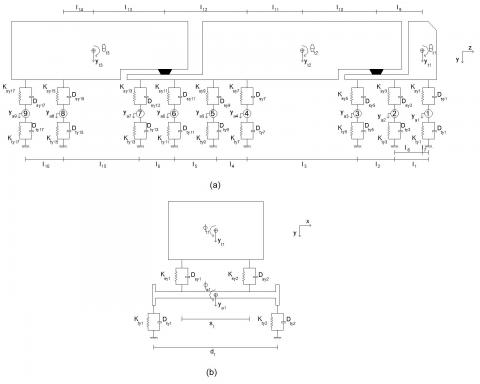
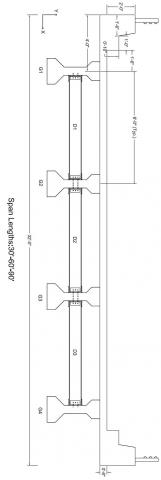

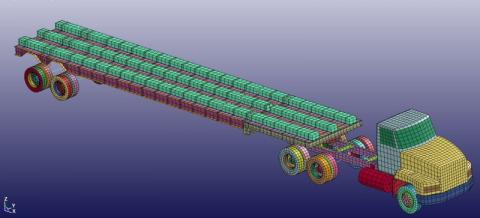
%20Girders%20under%20Heavy%20Vehicle%20Load(2)45be.jpg?itok=koVPhemX)
